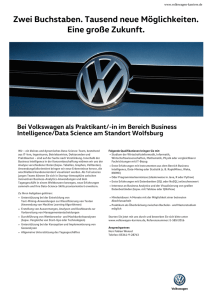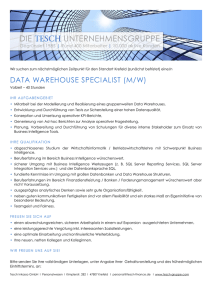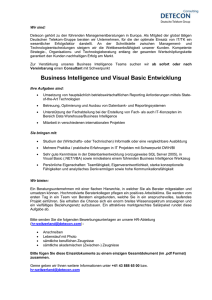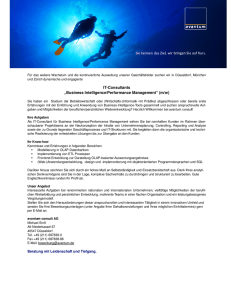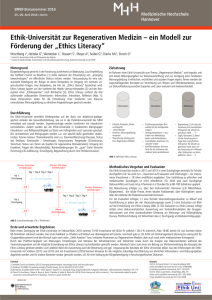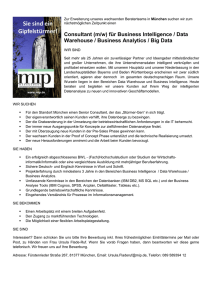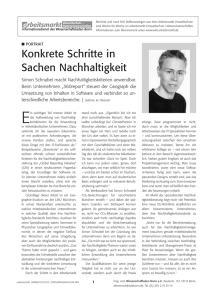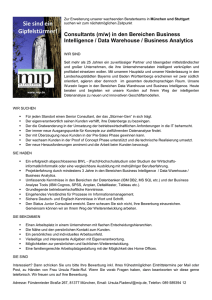Künstliche Intelligenz – Auswirkung aktueller Entwicklungen im
Werbung
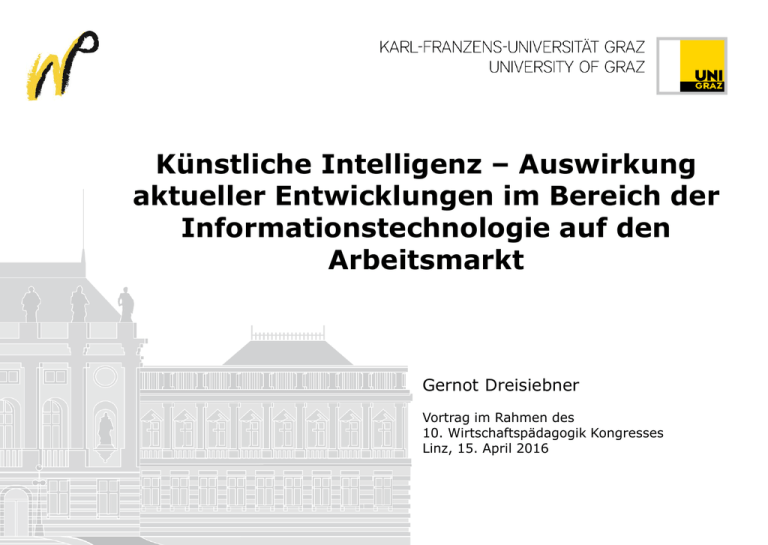
Künstliche Intelligenz – Auswirkung aktueller Entwicklungen im Bereich der Informationstechnologie auf den Arbeitsmarkt Gernot Dreisiebner Vortrag im Rahmen des 10. Wirtschaftspädagogik Kongresses Linz, 15. April 2016 Lösen Sie folgende Rätsel in 3 Sekunden: Even a broken one of these on your wall is right twice a day. William Wilkinson‘s „An account of the principalities of Wallachia and Moldavia“ inspired this author's most famous novel. The Calcutta Cup, given to Rugby teams since 1879, has an elephant on top and is made from melted coins of this currency. Ausschnitt verfügbar unter youtube.com (2011): Miles vs. Watson Lösen Sie folgende Rätsel in 3 Sekunden: Even a broken one of these on your wall is right twice a day: Clock William Wilkinson‘s „An account of the principalities of Wallachia and Moldavia“ inspired this author's most famous novel: Bram Stoker The Calcutta Cup, given to Rugby teams since 1879, has an elephant on top and is made from melted coins of this currency: Rupies Künstliche Intelligenz Auswirkung aktueller Entwicklungen im Bereich der Informationstechnologie auf den Arbeitsmarkt Menschliche Intelligenz Künstliche Intelligenz (KI) Allgemeine kognitive Leistungsfähigkeit eines Individuums „Artificial intelligence (AI) is the study of how to make computers do things which, at the moment, people do better.” Gekennzeichnet durch Selbstregulation des Handelns (Werbos 2009, Ryle 1951) (Rich & Knight 1991, S. 3) Zentrale Fragestellung Welche Implikationen ergeben sich aus diesen Innovationen im Bereich der Informationstechnologie für wirtschaftliche Berufe am Arbeitsmarkt und für das von Individuen benötigte Kompetenzspektrum? Künstliche Intelligenz Auswirkung aktueller Entwicklungen im Bereich der Informationstechnologie auf den Arbeitsmarkt Organisationale Perspektive Rationalisierungspotenziale Arbeits -markt Individuelle Perspektive Benötigtes Kompetenzspektrum ändert sich Strukturveränderungen (demografischer Wandel, technologischer Fortschritt, …) Strukturveränderungen am Arbeitsmarkt Nachfrage nach IT-Qualifikationen • Fortschritte im Bereich der KI: Negativer Effekt auf Arbeitsmarkt antizipiert (World Economic Forum, 2016) • Ausbildungssituation: AbsolventInnen IT-Erstausbildung* AHS AbsolventInnen nach Qualifikationslevel 790 Lehrlingsausbildung 881 BMS 882 öff. Universitäten IT-Masters 1484 IT-Experts 4238 1309 IT-Advanced Fachhochschulen 3734 1944 BHS 3928 0 1000 2000 3000 * Nicht angeführt: Universitäts- und FH-Lehrgänge; Privatuniversitäten. 4000 IT-Basics 494 0 1000 2000 3000 4000 Eigene Darstellungen; Daten nach Dornmayer (2012, S. 3-5). Organisationale Perspektive: Anwendungsszenarien und Rationalisierungspotenziale Business Intelligence Systeme, ERP-Systeme Dreisiebner & Stock (2015), S. 105 Semantic Web, Intelligent Agents Dreisiebner & Stock (2015), S. 109 Organisationale Perspektive: Wissensmanagement Business Intelligence Systeme, Wissensmanagement Repräsentation von Wissen trotz Komplexität (Varela 1990) zentrales Anliegen der KIForschung (Hansen & Neumann 2007) KI als zentrale Komponente Wissensmanagementsysteme (Liebowitz 2001), u.a. für Expertensysteme Intelligent Agents Data Mining Dreisiebner & Stock (2015), S. 105 Individuelle Perspektive: Erforderliches Kompetenzspektrum wandelt sich Information Literacy (Merchant 2007) Digital Competence (Ferrari et al. 2012) Digital Literacy (Arthur 2013) Media Literacy (Scheibe & Rogow 2012) New Literacies (Ng 2012) 21st Century Skills (Rotherham & Willingham 2009) Fähigkeit zum Umgang mit Information, digitalen Medien, Informationstechnologie Output Mensch Maschine Input Individuelle Perspektive: Neue Wege der Kompetenzentwicklung Maschine Mensch Mensch • Computer als Coach und Lernpartner (anstatt Arbeitsinstrument) • Lernen im Prozess der Arbeit gewinnt an Bedeutung • Triale Kompetenzentwicklung mit menschlichen und digitalen Lernpartnern Erpenbeck & Sauter (2013). Grafik: Eigene Darstellung. Individuelle Perspektive: KI begleitet Lernprozesse als Digital Tutor • Bereits früh Bestrebungen, KI-Systeme als Digital Tutors einzusetzen (Anderson, Boyle, & Reiser 1985; Millward 1979) • Fortschritte im Bereich des maschinellen Lernens (Jordan & Mitchell 2015) ermöglichen: Intelligent Tutoring Systems, welche grundlegende Strategien der Instruktion beherrschen (Ma, Adesope, Nesbit, & Liu 2014) Neue Anwendungsmöglichkeiten im Game-Based Learning (Lester et al. 2013) Automatisierte Bewertung von Aufsätzen (McNamara, Crossley, & Roscoe 2013) Educational Data Mining (Kotsiantis, 2012) Individuelle Perspektive: Erforderliches Kompetenzspektrum Information Literacy (Merchant 2007) Digital Competence (Ferrari et al. 2012) Digital Literacy (Arthur 2013) Media Literacy (Scheibe & Rogow 2012) New Literacies (Ng 2012) 21st Century Skills (Rotherham & Willingham 2009) Fähigkeit zu - Informationsverarbeitung - kritischem Denken - Reflexion -… Output Mensch Maschine Input Künstliche Intelligenz Auswirkung aktueller Entwicklungen im Bereich der Informationstechnologie auf den Arbeitsmarkt „Ohne • Lernen im Prozess der Arbeit, • ohne Werte und Gefühl, • ohne Kompetenzentwicklung, • ohne Lernen via Cloud Computing, • ohne Lernen in semantischen Netzen, geht in der Zukunft, die immer und vor allem auch Lernzukunft ist, gar nichts!“ (Erpenbeck & Sauter 2013, S. 5) Künstliche Intelligenz – Auswirkung aktueller Entwicklungen im Bereich der Informationstechnologie auf den Arbeitsmarkt Gernot Dreisiebner [email protected] Vortrag im Rahmen des 10. Wirtschaftspädagogik Kongresses Linz, 15. April 2016 Literatur Anderson, J. R., Boyle, F. C. & Reiser, B. J. (1985). Intelligent tutoring systems. Science 228 (4698), 456–462. doi:10.1126/science.228.4698.456 Arthur, S. C. M. (2013). Digital Literacy in a Global Context. In S. Kurbanoğlu, E. Grassian, D. Mizrachi, R. Catts & S. Špiranec (Hrsg.), Worldwide Commonalities and Challenges in Information Literacy Research and Practice (S. 141–147). Cham: Springer. Bierre, Pierre (1984). The Professor’s Challenge. AI Magazine, 5 (4), 60-70. doi:10.1609/aimag.v5i4.458 Dornmayr, H. (2012). IT-Qualifikationen 2025 (Kurzfassung des ibw-Forschungsberichts Nr. 170). Institut für Bildungsforschung der Wirtschaft (ibw). http://www.ibw.at/components/com_redshop/assets/document/product/1355914334_kurzfassung_fb170.pdf. Erpenbeck, John & Sauter, Werner (2013). So werden wir lernen! Kompetenzentwicklung in einer Welt fühlender Computer, kluger Wolken und sinnsuchender Netze. Berlin: Springer. Ferrari, A., Punie, Y. & Redecker, C. (2012). Understanding Digital Competence in the 21st Century: An Analysis of Current Frameworks. In D. Hutchison, T. Kanade, J. Kittler, J. M. Kleinberg, F. Mattern, J. C. Mitchell et al. (Hrsg.), 21st Century Learning for 21st Century Skills (S. 79– 92). Berlin: Springer. Hansen, H. R. & Neumann, G. (2007). Arbeitsbuch Wirtschaftsinformatik. IT-Lexikon, Aufgaben und Lösungen. Stuttgart: Lucius & Lucius. Jordan, M. I. & Mitchell, T. M. (2015). Machine learning: Trends, perspectives, and prospects. Science 349 (6245), 255–260. doi:10.1126/science.aaa8415 Kotsiantis, S. B. (2012). Use of machine learning techniques for educational proposes. A decision support system for forecasting students’ grades. Artificial Intelligence Review 37 (4), 331–344. doi:10.1007/s10462-011-9234-x Lester, J. C., Ha, E. Y., Lee, S. Y., Mott, B. W., Rowe, J. P. & Sabourin, J. L. (2013). Serious Games Get Smart: Intelligent Game-Based Learning Environments. AI Magazine 34 (4), 31–45. Liebowitz, J. (2001). Knowledge management and its link to artificial intelligence. Expert Systems with Applications 20 (1), 1–6. doi:10.1016/S0957-4174(00)00044-0 Ma, W., Adesope, O. O., Nesbit, J. C. & Liu, Q. (2014). Intelligent tutoring systems and learning outcomes. A meta-analysis. Journal of Educational Psychology 106 (4), 901–918. doi:10.1037/a0037123 McNamara, D. S., Crossley, S. A. & Roscoe, R. (2013). Natural language processing in an intelligent writing strategy tutoring system. Behavior research methods 45 (2), 499–515. doi:10.3758/s13428-012-0258-1 Merchant, G. (2007). Writing the future in the digital age. Literacy 41 (3), 118–128. doi:10.1111/j.1467-9345.2007.00469.x Millward, R. (1979). Teaching a computer to teach. Behavior Research Methods & Instrumentation 11 (2), 102–110. doi:10.3758/BF03205628 Ng, W. (2012). Can we teach digital natives digital literacy? Computers & Education 59 (3), 1065–1078. doi:10.1016/j.compedu.2012.04.016 Rich, E. & Knight, K. (1991). Artificial intelligence. New York: McGraw-Hill. Rotherham, A. J. & Willingham, D. (2009). 21st Century Skills: The Challenges Ahead. Educational Leadership 67 (1), 16–21. Scheibe, C. & Rogow, F. (2012). The teacher's guide to media literacy. Critical thinking in a multimedia world. Thousand Oaks: Corwin. Searle, John R. (1980). Minds, brains, and programs. Behavioral and Brain Sciences, 3 (03), 417-457. doi:10.1017/S0140525X00005756 Varela, Francisco J. (1990). Kognitionswissenschaft-Kognitionstechnik. Eine Skizze aktueller Perspektiven. Frankfurt am Main: Suhrkamp. Werbos, Paul J. (2009). Intelligence in the brain: A theory of how it works and how to build it. Neural Networks, 22 (3), 200-212.

